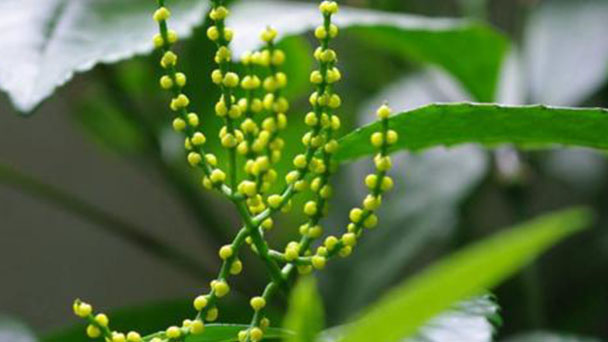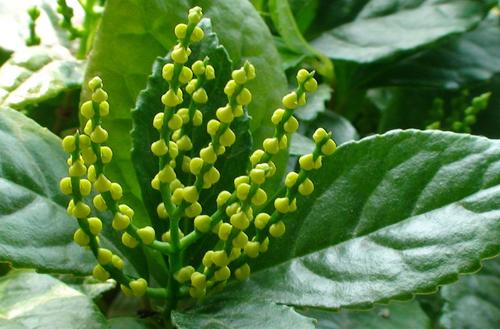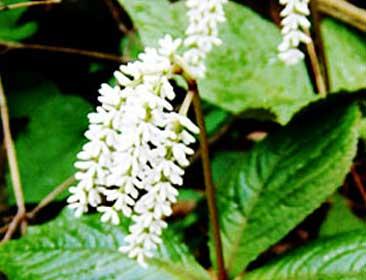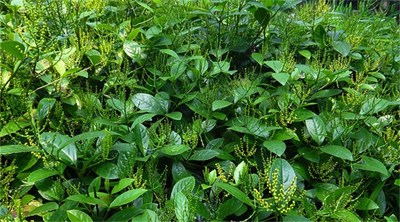Chloranthus spicatus profile
Written by Maggie
Mar 18 2021

Chloranthus spicatus is an evergreen, perennial orchid herb with clumps of plants ranging from 30 to 100 cm in height. Stem node is obvious, stem erect and slightly diffused, branching on node.
Chloranthus spicatus has opposite, oval, dark green, glossy leaves with a wrinkled, slightly foamy face. Spices are born on the top of new branches. The flowers are small, green at first and then turn golden. They have a strong fragrance.
Chloranthus spicatus is an evergreen perennial herbaceous plant of the chloranthus spicatus family. The plant height is 60 cm. The base of the old plant is lignified, and the stem is upright and slightly scattered.
Chloranthus spicatus picture

Morphological characteristics of Chloranthus spicatus
Chloranthus spicatus is a subshrub, upright or slightly prostate, 30-60 cm tall. Stem is cylindrical, glabrous. Leaves are opposite, thick papery, elliptic or ovate-elliptic, 5 -- 11 cm long and 2.5 -- 5.5 cm wide, apical acute or obtuse, base cuneate, margin crenate-dentate, apex with a glandular, ventral dark green, bright, back yellowish-green, lateral veins 6 -- 8 pairs, slightly raised on both sides; Petiole of chloranthus spicatus is 8-18 mm long, more or less connate at base; Stipules are minute.
Spices of Chloranthus spicatus arranged in panicles, usually terminal, rarely axillary, bracts triangular. The flowers are small, yellow-green, very fragrant, with 3 stamens. The septum formed into an ovoid, the upper part was irregular and 3 lobes, and the central lobe was large. Sometimes terminal shallowly 3-lobed, with 1 2-loculed anther, bilateral lobes smaller, with 1 1-loculed anther on each side, ovary obovate.
Chloranthus spicatus has opposite, oval, dark green and glossy leaves with a wrinkled, slightly foamy face. Spices are born on the top of new branches, small flowers, green at first and then turn golden yellow.
Chloranthus spicatus is erect or slightly diffuse, with older plants having slightly lignified bases and prominent nodules. Leaves are opposite, margin obtuse teeth, apex with glands. Spices many terminals. The flowers are small, bisexual, without perianth, yellow-green, 3 male flowers, and fragrant. Drupe is globose, green.
Chloranthus spicatus is a perennial evergreen herb or semi-shrub flower. Chloranthus spicatus is erect or slightly prostrate, 30-60 cm high.Leaves opposite, obovate elliptic, margin has blunt teeth, teeth tip has a gland; Leaves are smooth, dark green, slightly bubbly wrinkled. Spices are terminal, arranged in panicles. The flowers are small, bisexual, tepeless, yellow-green, with a strong orchid fragrance.
Ecological habits of Chloranthus spicatus
Chloranthus spicatus thrive on warm, moist, shaded environments and fertile soil. Growth suitable temperature 20-25 degrees Celsius, winter to maintain 10 degrees Celsius above, in eastern China must be potted, winter to overwintering in the greenhouse.
Chloranthus spicatus lives in dense forests of mountain slopes and valleys at an altitude of 150-990 meters. However, Chloranthus spicatus is rarely found in the wild and is mostly cultivated in many areas. Chloranthus spicatus likes a warm, moist and ventilated environment, like shade, and avoids scorching sun, the requirements of loose and fertile, humus rich, good drainage soil.
Chloranthus spicatus can tolerate the low temperature of 5-10℃. It can basically overwinter in the open ground in the West Sichuan Plain of China, and it can also grow normally in the open ground in the winter in Ya 'an region. Chloranthus spicatus likes a warm and humid environment, requires good drainage and humus rich acid soil, the root system is afraid of water stains, otherwise easy to rot caused by stem and leaves dry. In direct sunlight and poor drainage places and alkaline soil are not suitable for planting chlorophyllum.
How to grow and care for Chloranthus spicatus
Water
Chloranthus spicatus prefers wet weather, which requires daily watering in the summer and dry weather.Often irrigate leaf water, rainy season control watering, avoid water, rain to pour basin water.
Chloranthus spicatus likes a humid environment, should always keep the basin soil moisture and higher air humidity, but can not water.
Fertilizer
Chloranthus spicatus prefers fertilizer, and Chloranthus spicatus often applies thin fertilizer. Topdressing can be often applied in the flowering period, and it is better to dilute the cooked cake fertilizer. Liquid fertilizer was applied every 1-2 weeks during the growth period.
Soil
Chloranthus spicatus requires loose, fertile, humus-rich, well-drained sandy loam. Use general cultivated soil to mix 20% river sand. Potted can use rot leaf soil or peat: add 1/4 perlite or river sand and a few base fertilizer to match the culture soil, also can use fine sand.
Temperature
Chloranthus spicatus is warm, growing at 15-30℃ and overwintering at more than 5℃. Winter should be placed in the temperature of 10℃ : above the room overwintering.
The optimal rooting temperature for cuttings is between 18℃ and 25℃, lower than 18℃, it is difficult and slow for cuttings to rooting. If the temperature is higher than 25℃, the cuttings are susceptible to bacterial infection and rot, and the higher the temperature is, the greater the proportion of rot is. Cuttings encountered at low temperature, insulation measures are mainly used to use the film cutting pot or container wrapped up. Cuttings after the temperature is too high, cooling measures are mainly to shade cuttings, to cover 50-80% of the sun, at the same time, to spray cuttings, 3-5 times a day, the number of sunny days with higher spray temperature is more, rainy days with lower temperature, the number of spray is less or not spray.
Light
Chloranthus spicatus loves the sun, but avoids direct sunlight. Chloranthus spicatus should enjoy shade during the summer. For greenhouse cultivation in North China, more than 70% of the sunlight should be blocked in spring, summer and autumn, and about 30% in winter. Summer can be moved to outdoor shade canopy cultivation. Never expose Chloranthus spicatus to the sun in the open air, otherwise it will cause serious sunburn. In the family, Chloranthus spicatus can be placed in the bright indoor perennial cultivation appreciation, and can also be arranged as a view of the leaf plant in the guesthouse, hotel hall and indoor garden. Chloranthus spicatus can appreciate continuously in darker indoor 3, 4 weeks, restore in a stronger ray place hind, cultivate 2 periods of time, and can put back dark indoor appreciation again.
Humidity
The relative humidity of the air must be maintained at 75-85% after cutting. You can spray cuttings to increase the humidity, 1-3 times a day, the higher the temperature on sunny days, the more times the spray, the lower the temperature on cloudy and rainy days, the fewer or no spray. But if sprayed too much, the cuttings are susceptible to disease and rot, because many kinds of disease are present in water.
Potted points
Potted with 2 copies of leaf rot soil, 2 copies of rice chaff ash, 6 copies of yellow mud mixed culture soil, mixed with 20% river sand, in order to facilitate ventilation and drainage. Avoid direct sunlight, so summer should be placed under the shade or forest scattering light conservation. Chloranthus spicatus likes moisture, not drought tolerance, basin soil too dry will cause leaf sag; Days more, the leaves will wilt and fall, affecting growth and flowering. But the basin soil is often too wet, or water after rain, can also lead to poor root growth and rotten leaves.

The propagation of Chloranthus spicatus
Chloranthus spicatus often propagates by layering, cuttings, and splitting, both of which can be used for propagation.
Division
Chloranthus spicatus division takes place in early spring, when the temperature cannot fall below 5 ° C. Cuttage in the plum rain season, take 2 years of robust branches 6-10 cm, take the year of the fall of the tender cuttings, matrix with coarse river sand, leaf rot soil and other phases, maintain humidity, 40 days rooting.
Layering
In the plum rainy season with 2 ~ 4 branches gathered together, slightly cut. Buried soil 3-4 cm, about 2 months can be cut with the mother plant, another plant. Cuttage in 5 - July, select with internode branches, long 5-7 cm. Root about 30 days after insertion. Planting is usually carried out in the spring when the potting is changed. The best time is the second half of the flower.It is best to choose strong 2-year old branches for layering, which can take root in 30-40 days.
Cutting
Chloranthus spicatus cutting is generally carried out before sprout in spring, and the effect is better with a set basin method. With a small earthen basin, caliber about 15 centimeters, the bottom hole blocked to make it watertight, another take a caliber about 35 centimeters of the big basin, the bottom hole is not blocked. Place the small pot in the center of the large pot, fill the mountain soil or culture soil between the two pots, fill the small pot with water, so that the water gradually seeps into the soil from the small wall of the earthen pot. Took 6-10 cm strong branches, retained the top 1 to leaf, inserted into the soil half, master the basin soil humidity, do not make it too wet, 30 days rooting leaves, the fall or the next spring basin.When seedlings grow 4-5 sections, pay attention to the heart, to promote the birth of branching.
Disease control of Chloranthus spicatus
Common pests and diseases of Chloranthus spicatus include stem rot, sclerotia, and leafhoppers.
Stem rot disease, sclerotia disease
Prevention and control method: spray with 10% topujin wettable powder 500 times liquid.
Leafhoppers
Prevention method: use 2.5% enemy to kill 3000 times liquid spray kill.
The distribution area of Chloranthus spicatus
Chloranthus spicatus grows at an altitude of 150 to 990 meters and is mainly distributed in Yunnan and Fujian provinces in China. Chloranthus spicatus can tolerate low temperatures of around 7 degrees Celsius. The stems are tufted, shrubby, with opposite leaves and soft stems that extend well into the surrounding environment.
Chloranthus spicatus is found in Yunnan, Sichuan, Guizhou, Fujian and Guangdong provinces. It is also cultivated in Japan. Chloranthus spicatus is common in southern China but rare in the wild. Chloranthus spicatus is widely cultivated.
Chloranthus spicatus is produced in Yunnan, Sichuan, Guizhou, Fujian, Guangdong and other places in China. Chloranthus spicatus is more than born on the hillside, gully dense forest, 150-990 meters above sea level, but the wild is rare, mostly for cultivation. It is also cultivated in Japan.
Chloranthus spicatus uses
Ornamental value
Golden millet orchid stems cluster, was a shrub installed, opposite leaves, can well cover the ground, but also into a complete bead cluster. The stem of the tree is soft, the spatial extension direction is rich and varied, and the leaf apex is blunt, the base is cuneate, obovate, the surface is smooth, the leaf margin is serrate. In addition, orchid branches, leaves are green, very ornamental value.
Potted role
Spicate top branch end, small yellow flowers, a strong fragrance, summer family cultivation, rich flowers, suitable for the window, balcony, flower shelf display, fragrance filled with room, it is relaxed and happy.
Spices role
Chloranthus spicatus is an aromatic oil extracted from the flowers and rhizomes of Chloranthus spicatus. Chloranthus spicatus is often used to smoke tea leaves, known as Chloranthus spicatus.
Medicinal value
Chloranthus spicatus and rhizomes are used to extract aromatic oils from Chloranthus spicatus and from flowers. Chloranthus spicatus and rhizomes are often used to smoke tea leaves. The whole plant is used as medicine to treat rheumatism pain and injury. Rhizome mash can treat sores. Poisonous, with proper caution.
Flowers and rhizomes of Chloranthus spicatus can extract aromatic oil, flowers very fragrant, often used for fumigating tea. The whole plant is used as medicine to treat rheumatism pain and injury. Rhizome mash can treat sores. Poisonous, use carefully.

Latest Updated
- Benefits of Bugleweed - 7 Science-backed Health Benefits
- Bugleweed Dangers & Side Effects - Is It Poisonous?
- How to Plant Evergreen Trees - What You Should Know
- When to Plant Evergreens - Grow Guide for Evergreen Trees
- 12 Wonderful Evergreen Shrubs for Your Garden
- 12 Popular Evergreen Plants with Pictures for Beginners
- When And How To Prune A Lilac Bush Like a Pro
- How to Grow & Care for Lilac Vine (Hardenbergia Violacea)
- Japanese Lilac Tree (Syringa Reticulata) Care & Propagation Guide
- Shumard Oak Pros and Cons - What to Know
Popular Articles
- Winter maintenance of Antirrhinum Majus
- How to Grow Terminalia Mantaly Tree
- How to Grow and Care for Crossostephium Chinense
- How to grow Antirrhinum Majus in spring
- Peristeria Elata (Dove Orchid) Profile: Info & Care Guide
- Underwatered Snake Plant (Sansevieria Trifasciata) - Signs And How To Fix
- How to Care for Brazilian Jasmine Plant (Mandevilla Sanderi)
- How to Grow & Care for Graptopetalum Purple Delight in Summer
- Rosa Chinensis (China Rose): Plant Growing & Care Tips
- How to Care for Baby Sun Rose (Aptenia Cordifolia)